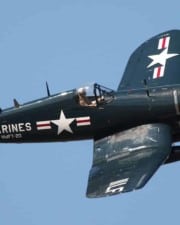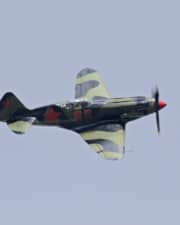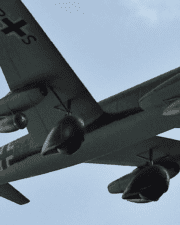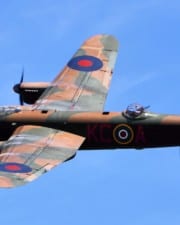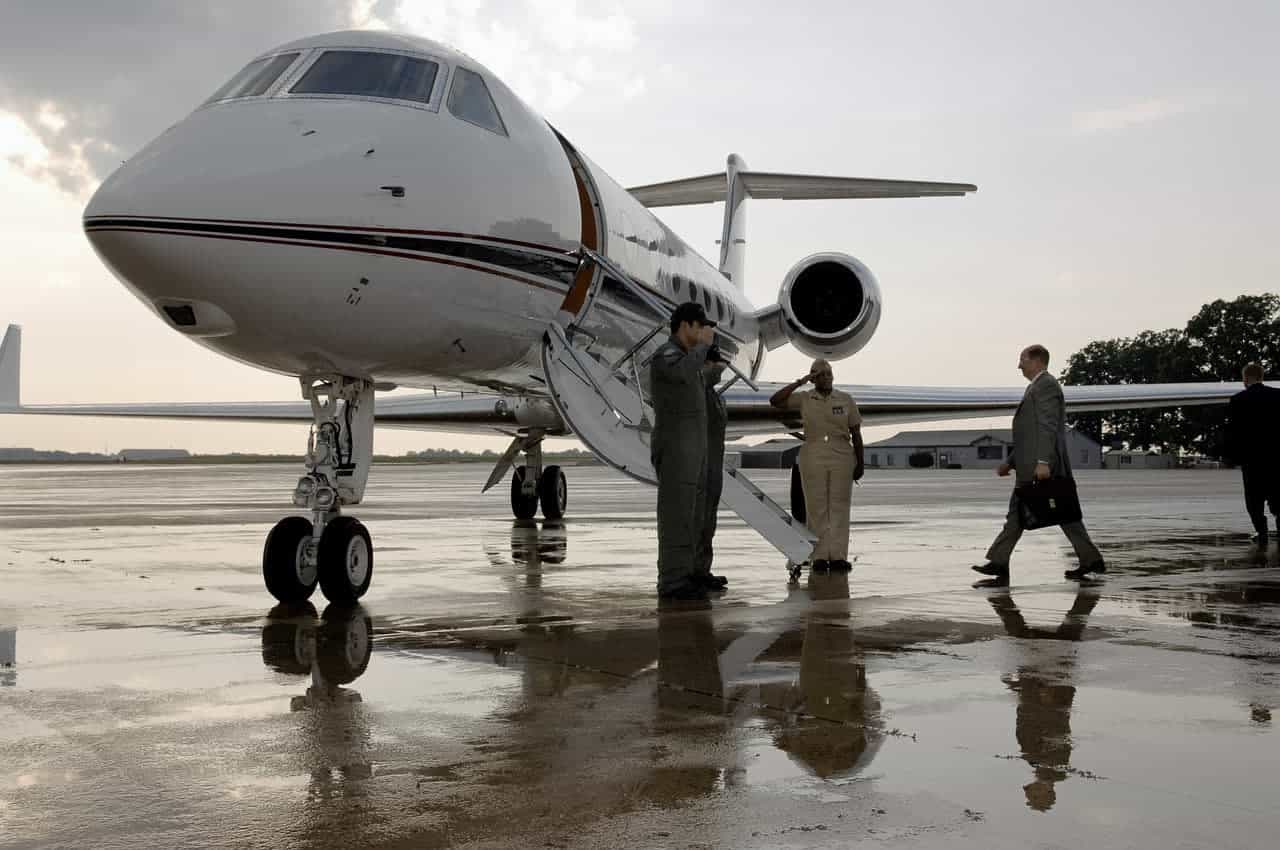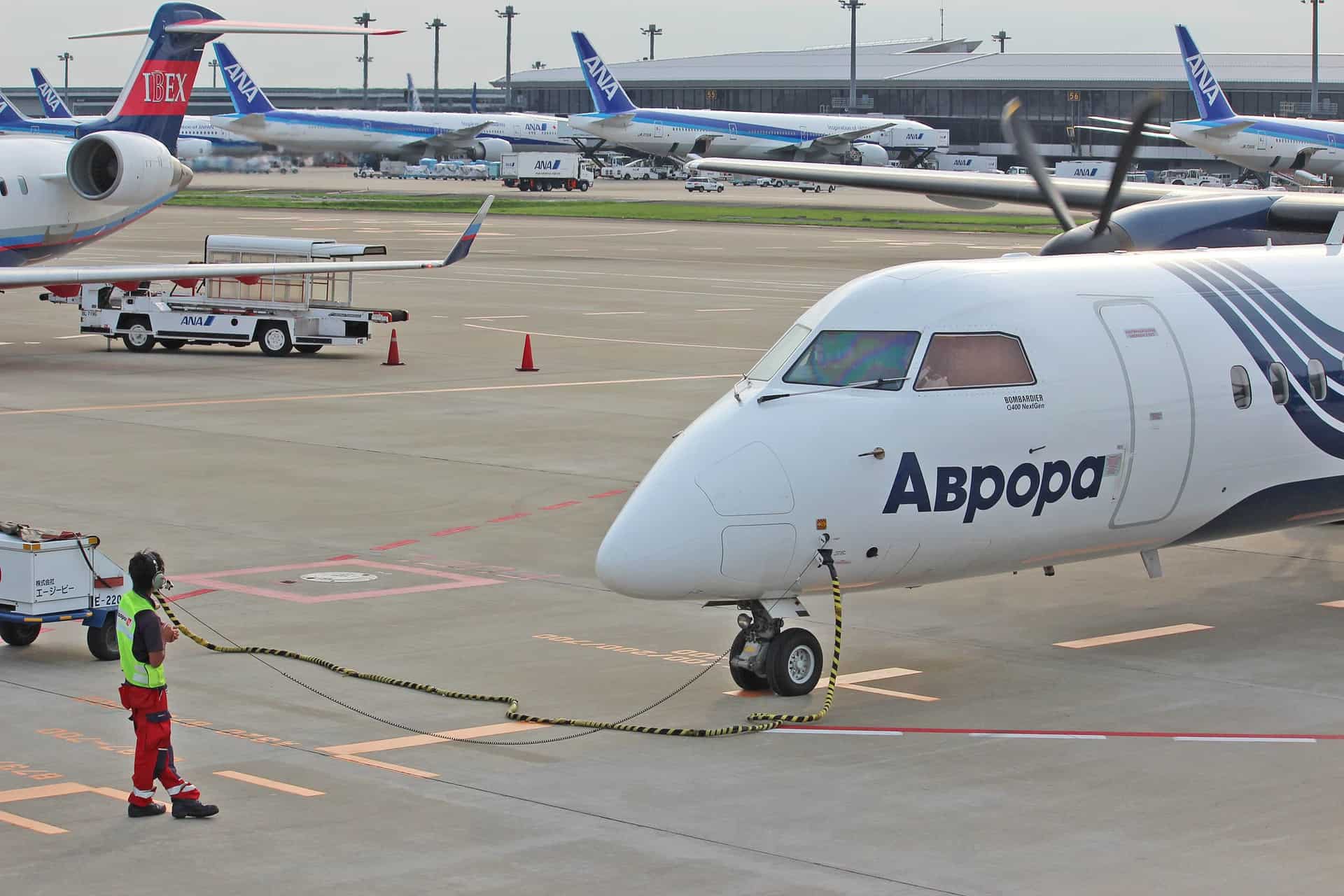World War II brought the fastest advance in aviation ever seen. With the invention of the jet engine and rocket propulsion, planes became more powerful and pilots could reach speeds they had only imagined. But which of these brilliant warbirds takes the trophy for the fastest plane of WW2? Find out in the list below…
WW2 began with practical and basic machines, but ended with planes so advanced they look like something the X-Men would fly. Today warbirds are still considered to be some of the most brilliant flying machines ever created. In the space of 5 years, aerial warfare was utterly transformed, and the presence of never-seen-before technology had revolutionized aviation as we know it.

But which of these ground-breaking flying machines was the fastest? Join me as I count down from the top 13.
Table of Contents
- 13. Focke-Wulf Fw 190 – (405 mph)
- 12. Lockheed P-38 Lightning – (414 mph)
- 11. Republic P-47 Thunderbolt – (426 mph)
- 10. North American P-51 Mustang – (440 mph)
- 9. Vought F4U-4 Corsair – (446 mph)
- 8. Arado Ar 234 Blitz – (462mph)
- 7. Dornier Do-335 A1 – (474 mph)
- 6. De Havilland Hornet F1 – (475 mph)
- 5. Heinkel He 162 – (495 mph)
- 4. Messerschmitt Me 262 – (560 mph)
- 3. Lockheed P-80 Shooting Star – (594 mph)
- 2. Supermarine Spitfire – (606mph)
- 1. Messerschmitt Me 163 Komet – (702 mph)
13. Focke-Wulf Fw 190 – (405 mph)
Top speed: 352 knots / 405 mph
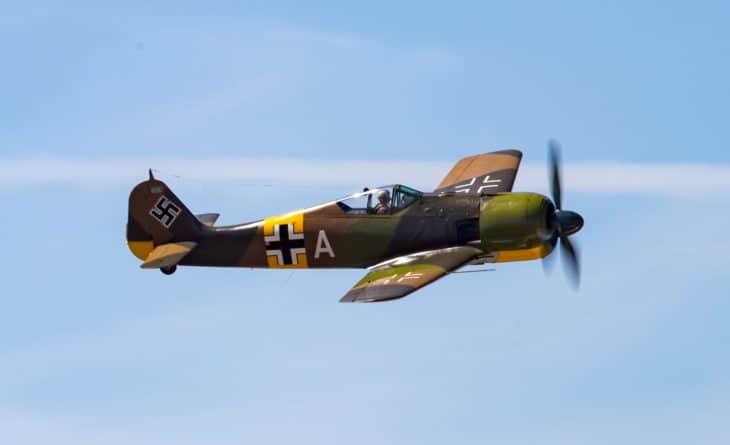
Making its debut in 1941, the FW190 was exceptionally versatile. With fighter, interceptor and ground attack capabilities, it is widely considered the best (german) fighter plane of World War 2.
It wasn’t until a German pilot accidentally landed on an Allied airstrip (mistaking Wales for somewhere on the Constantin Peninsula) that the UK acknowledged the existence of the Fw-190. Its subsequent capture was of huge benefit to the British, who stole many of its features for future designs, such as the Hawker Fury.
To continue competing with the Allies, the Germans developed the long-nosed ‘Dora’ model. Its talent as a high-altitude interceptor was so great that most of its pilots considered it superior to the P-51 Mustang.
12. Lockheed P-38 Lightning – (414 mph)
Top speed: 360 knots / 414 mph
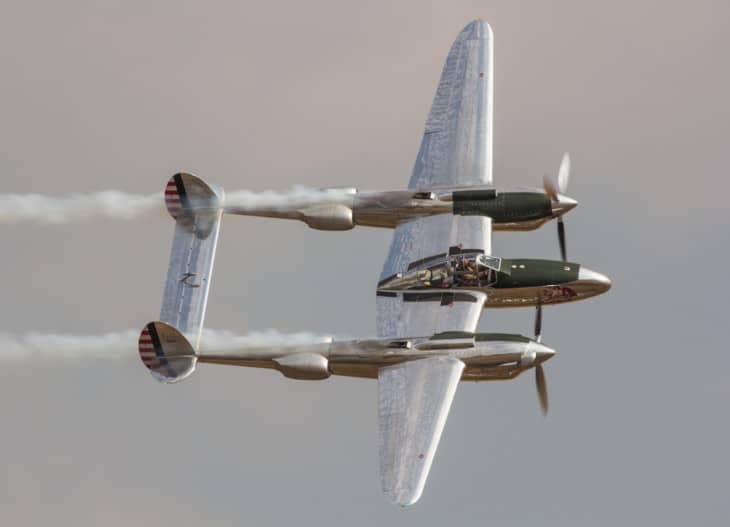
Nicknamed the fork-tailed devil, The P-38 Lightning was the plane that every airman wanted to fly. Fully-loaded with four 50-caliber machine guns and a 20-mm cannon, it weighed over 10 tons, making it the second heaviest fighter of the time. Despite this, its two supercharged engines gave a range of 1150 miles and a 3000ft per minute rate of climb. It was a beast.
Early models suffered from engines coming apart mid-flight. As a result, this plane was a disappointment in Europe and was considered too complicated for the average pilot. If sprung on by enemies, there were so many switches to turn that the plane was often shot down before the pilot could retaliate or escape.
In the Pacific War however the Lightning was hugely successful, shooting down more Japanese airplanes than any other fighter and flying over 130,000 missions around the world.
11. Republic P-47 Thunderbolt – (426 mph)
Top speed: 374 knots / 426mph
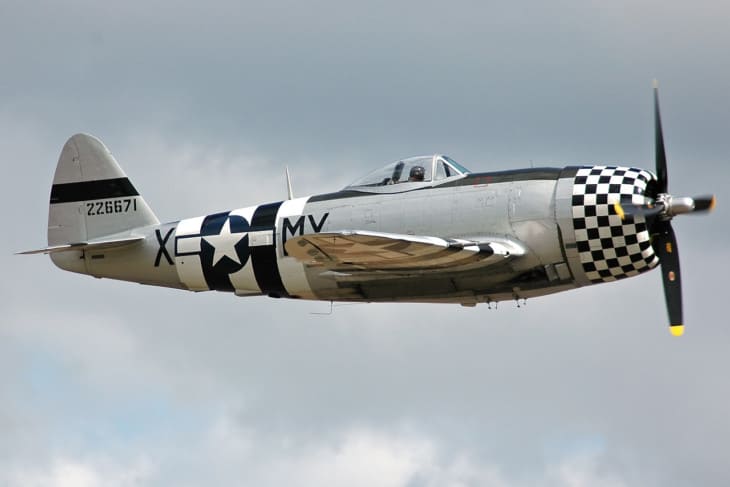
Nicknamed the “Jug”, the P-47 Thunderbolt should have been named the ‘cockroach’, owing to its durability. Able to withstand considerable battle damage and remain airworthy, only 0.7% were lost in action!
Entering service in 1942, this fighter was the heaviest in the skies and packed a punch. At 10.6 tons, it was double the size and weight of the P-51 but could still match its speed. What’s more, it could fly at altitudes over 40,000ft and could out-dive any plane in Europe.
With a comfortable cockpit and excellent visibility from its bubble canopy, the P-47 was a favorite among pilots. Flying over half a million sorties during the war and demolishing nearly 4,000 enemy aircraft, 9,000 trains, 86,000 trucks and 6,000 armored vehicles, the Jug racked up an impressive total.
10. North American P-51 Mustang – (440 mph)
Top speed: 383 knots / 440 mph
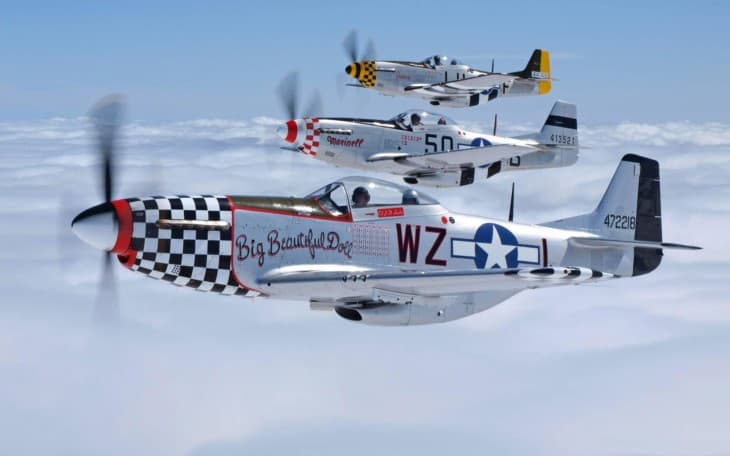
Once a Mustang got on your tail, it was nearly impossible to shake it off. That was the opinion of most airmen during WW2. One of America’s most astounding wartime fighters, the mustang had the speed and agility to out-maneuver most other fighters.
With the capacity to carry 2000lb of bombs and an incredible range of 2200km, the P-51 was an effective bomber escort and overturned the previous failures of the Allies’ aerial bomb runs.
Named after the wild ponies that roamed American West, this plane was an exceptionally capable machine once upgraded to the British-made Merlin 61 engine. A switch that earned it the reputation of ‘the plane that won the war’.
9. Vought F4U-4 Corsair – (446 mph)
Top speed: 388 knots / 446 mph
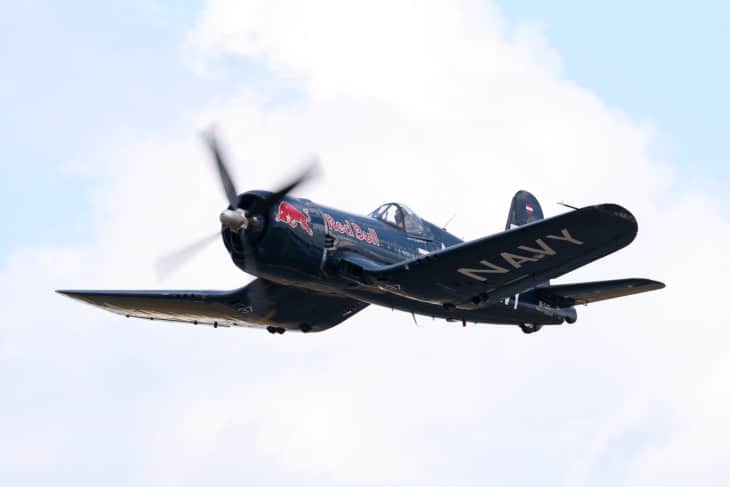
Although very late to the party, this was the first fighter to exceed 400mph and accrued an impressive combat record in the Pacific. The distinctive ‘gull wings’ gave the plane a low-drag design whilst providing sufficient ground clearance for the airplane’s huge propeller.
Known as the ‘Angel of Okinawa’ to Infantrymen but the ‘Bent-wing B*stard’ to pilots, at low speeds the engine produced massive amounts of torque that could easily twist the airplane upside down. Additionally, the visibility from the cockpit was terrible, making a landing on the small deck of an aircraft carrier almost impossible.
As a result many inexperienced pilots were killed operating the F4U, earning it the name of ‘Ensign Eliminator’ (Ensign being the lowest rank of a US naval officer). But despite this, the F4U’s excellent roll rate, high speed and maneuverability placed it among the best fighters of the war and it is still used by many aerobatics teams today.
8. Arado Ar 234 Blitz – (462mph)
Top speed: 402 knots / 462 mph
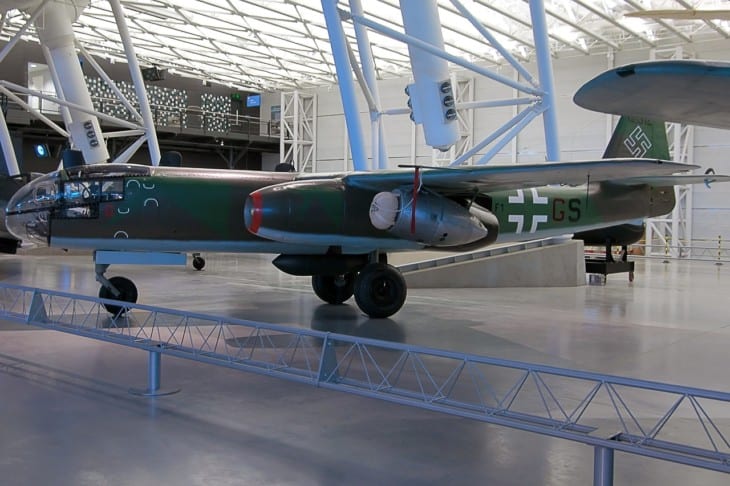
The first jet-bomber of WW2, the AR 234 was considered by Hitler to be one of Germany’s wonder weapons, and the saviour of Germany. It served in mostly reconnaissance roles and was rarely detected by the enemy. In the few bombing runs it did perform, it proved almost impossible to intercept, as few aircraft could achieve the same speeds in level flight.
But the Blitz suffered numerous shortcomings. The fragile engines needed replacing every 25 flying hours or less and its lengthy take-off roll caused many casualties.
Early prototypes took off from ejectable three-wheeled trolleys and landed on skids, instead of the usual landing gear, which apparently felt like ‘landing on soap’.
Thankfully the bomber version had a landing gear and problems with take-off were eventually solved with RATO (rocket-assisted take off).
7. Dornier Do-335 A1 – (474 mph)
Top speed: 412 knots / 474 mph

Also known as ‘The Arrow’, the Do 335 was the fastest piston of its time. The propellers were arranged in an unusual ‘push-pull’ configuration, with one engine on the front and one behind it. This eradicated the unpleasant torque effect often experienced in propeller-driven aircraft.
With this unique layout, ejecting a pilot from the plane was difficult. In order to solve this, the arrow jettisoned the tailfin and rear propeller so the pilot could bail out without his parachute sucking him into the rotor blades.
6. De Havilland Hornet F1 – (475 mph)
Top speed: 413 knots / 475 mph

Representing the peak of piston-technology, the Hornet F1 had excellent handling characteristics and reached the highest speed ever recorded in a British-made piston engine. Eric ‘Winkle’ Brown, who flew more plane types than any other pilot, said it was like flying a Ferrari in the sky and you could do ‘anything you wanted using just one of the Hornet’s engines, let alone using both’.
A successor to the Mosquito, the prototype was built for long-range operations in the Far East, but the conflict was over before the plane was formally introduced in 1946. Although it didn’t see service, the plane still had a lengthy combat career and was a success in later conflicts.
5. Heinkel He 162 – (495 mph)
Top speed: 430 knots / 495mph

Created as part of the Volksjager design competition, the ‘people’s fighter’ or ‘Salamander’ was designed to be rapidly mass produced by an unskilled workforce, including slave labour.
Made mostly of wood, it weighed around 2000kg and was designed to be so expendable, it could just be abandoned if too expensive to maintain.
By this time in the war, the Luftwaffe were being pummelled by Allied bombers, who were destroying their reserves of elite combat pilots and fuel.The plan was to use Hitler Youth as the pilots of the He 162, who were so fiercely loyal they would gladly sacrifice their lives for the cause. An outcome that would be quite likely, considering how little training they were to receive. Thankfully, this vision was never actualised and it was flown by veteran pilots until their air bases were captured.
The Salamander had an endurance of only 30 minutes and was extremely unstable. These shortcomings were the cause of most fatalities, not enemy fire.
4. Messerschmitt Me 262 – (560 mph)
Top speed: 490 knots / 560 mph
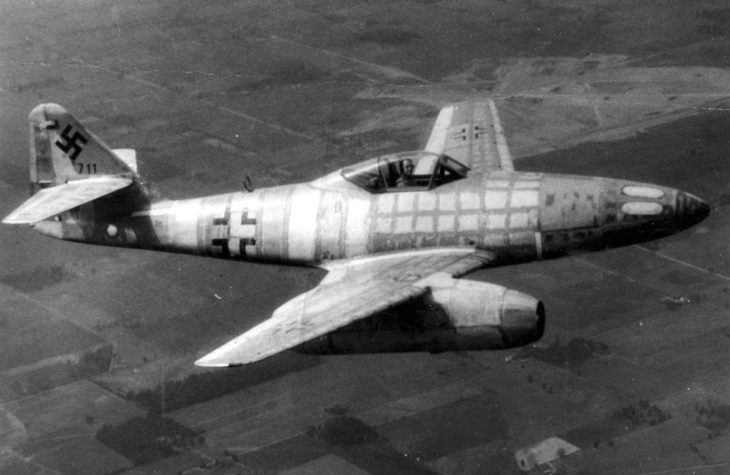
The Me 262 ‘Swallow’ was the only jet fighter to see air-to-air combat in WW2. If it had seen combat earlier in the war, the outcome may well have been very different. Only seeing action in the last 2 years, its introduction was too late to alter the tide of the war, despite the considerable dent it made in the allied fleet. It claimed 509 Allied kills with only 100 losses.
With two Junkers Jumo 004B-1 turbojets, it had a strikingly modern appearance and could easily outrun a mosquito in level flight. Able to carry 24 R4M air-to-air rockets, it had the firepower to execute any foe and one German pilot said flying it ‘was like being a god’.
The Me 262 proved to the world that jets were the future of aerial warfare and directly inspired the icons of the jet age, the MiG-15 and Sabre F-86.
3. Lockheed P-80 Shooting Star – (594 mph)
Top speed: 516 knots / 594 mph
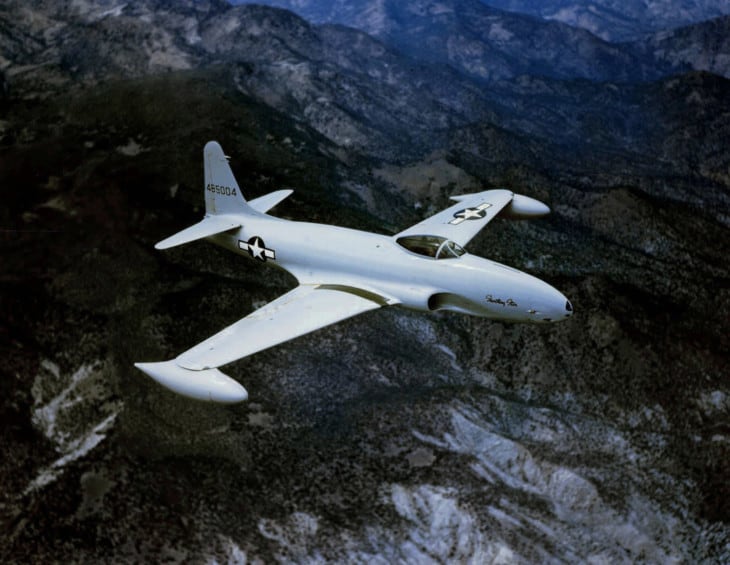
The shooting star was the first jet fighter used by the USAAF. The project was so secret that only five (out of the 130+ people working on it) knew what they were building. One engineer was even detained by the police because Lockheed officials could not vouch for him.
The P-80 was developed in response to received intelligence of the Me 262’s development. Using years of British jet engine research, American Manufacturer Lockheed set about creating a competitor. The first prototype was nicknamed Lulu-Belle and the USAAF were so impressed with it that it stayed in production for a full 15 years.
Like many of the planes on this list, the P-80 did not see action during WW2 but two pre-production versions of it did fly in Italy and in 1947 a modified version of this plane set a speed record of 624mph.
2. Supermarine Spitfire – (606mph)
Top speed: 526 knots / 606 mph
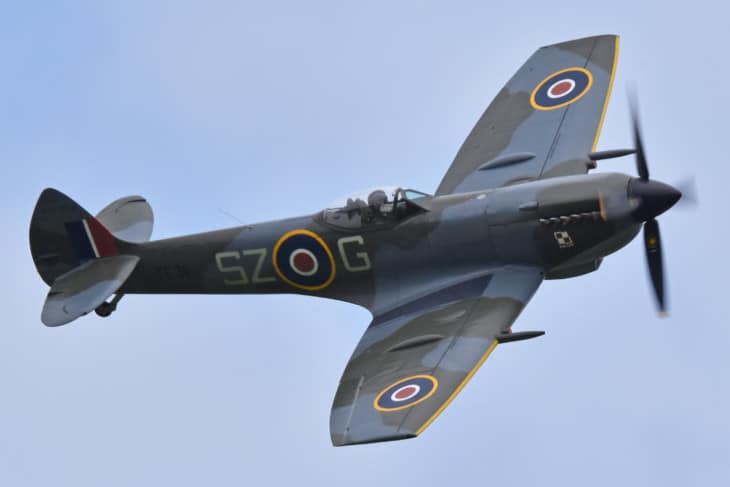
The icon of WW2 and the Battle of Britain. The Supermarine Spitfire was Britain’s sweetheart and a joy to fly. This beauty has a max speed faster than that of today’s commercial jets.
The name ‘spitfire’ was shared by the daughter of Supermarine’s chairman and was disliked by designer R J Mitchell who said it was “the sort of bl**dy silly name they would give it”.
Although the official max speed in 606mph, in April 1944 one pilot managed to reach 620mph when equipment designed to limit its speed failed. The propeller ripped off and the diving aircraft reached more than Mach 0.92 (92% of the speed of sound).
Having been knocked unconscious during this maneuver, Martindale woke to find his aircraft flying at 40,000ft with bent wings. Funnily enough, the new shape of the battered wings would eventually enable other planes to break the sound barrier.
1. Messerschmitt Me 163 Komet – (702 mph)
Top speed: 610 knots / 702 mph
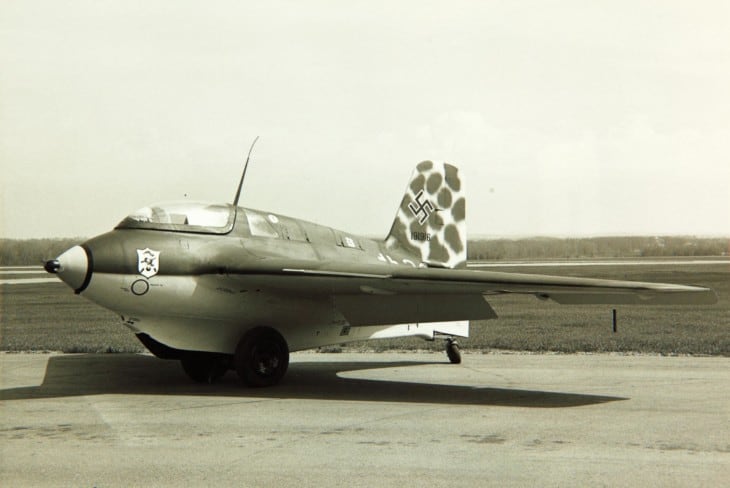
The fastest plane to see action during WW2, the Me 163 was powered by rockets and was lightyears ahead of its time. Setting the world speed record in 1941, it superseded its own record 3 years later during a dive at 702 mph.
Pilots endured special high-pressure training to avoid passing out at high altitudes but that was the least of their worries. The Komet was prone to spontaneous explosions, due to the volatile rocket-fuel. It also had a flight time of only 7 minutes. Unable to match its speed, Allies would follow the enemy back once it ran out of fuel and then strafe the airfield.
Originally equipped with guns only accurate at short-range, a SG500 Jagdfaust was later fitted to improve accuracy. Translated literally as ‘hunting fist’, this weapon consisted of six recoilless 50mm mortars that automatically launched when under the belly of an enemy bomber.
Although a scientific wonder for its time, the Me 163 only claimed 16 aerial victories and was retracted from operation a month before the German surrender. Therefore, despite being the fastest plane of WW2, it is also the worst fighter plane of WW2.
References ▾
- https://ourworldindata.org/technological-progress
- https://nationalinterest.org/blog/the-buzz/nazi-germanys-focke-wulf-fw-190-the-best-fighter-aircraft-21861
- https://www.historynet.com/p-38-flunked-europe.htm
- https://www.lockheedmartin.com/en-us/news/features/history/p-38.html
- https://militaryhistorynow.com/2015/04/20/the-jug-10-cool-facts-about-the-p-47-thunderbolt/
- https://www.nationalww2museum.org/visit/museum-campus/us-freedom-pavilion/warbirds/north-american-p-51-mustang
- https://www.eaa.org/eaa-museum/museum-collection/aircraft-collection-folder/1945-chance-vought-f4u-4-corsair---n6667
- https://sierrahotel.net/blogs/news/the-bent-wing-bastard
- https://www.si.edu/object/vought-f4u-1d-corsair:nasm_A19610124000
- https://www.wearethemighty.com/articles/this-top-secret-jet-bomber-spied-on-americans-in-normandy
- https://www.hitechcreations.com/wiki/index.php/Ar_234B
- https://www.militaryfactory.com/aircraft/detail.asp?aircraft_id=104
- https://www.warhistoryonline.com/military-vehicle-news/dornier-do-335-2.html
- http://www.aeroflight.co.uk/aircraft/types/type-details/dornier-do-335.htm
- https://theaviationgeekclub.com/the-story-of-the-de-havilland-hornet-the-cool-forgotten-successor-of-the-famous-mosquito/
- https://nationalinterest.org/blog/buzz/he-162-hitlers-massively-flawed-wooden-jet-fighter-31582?page=0%2C1
- https://theaviationgeekclub.com/the-story-of-the-de-havilland-hornet-the-cool-forgotten-successor-of-the-famous-mosquito/
- https://www.historyanswers.co.uk/inventions/the-messerschmitt-me-262-the-third-reichs-jet-fighter/
- https://www.businessinsider.com/nazi-germany-me-262-jet-fighter-changed-aerial-combat-2020-7?r=US&IR=T
- http://www.aviation-history.com/lockheed/p80.html
- https://military.wikia.org/wiki/Lockheed_P-80_Shooting_Star#Design_and_development
- https://www.bbc.com/future/article/20160505-the-spitfires-that-nearly-broke-the-sound-barrier
- https://nationalinterest.org/blog/the-buzz/the-super-scary-legend-nazi-germanys-me-163-rocket-fighters-18494
Related Posts



